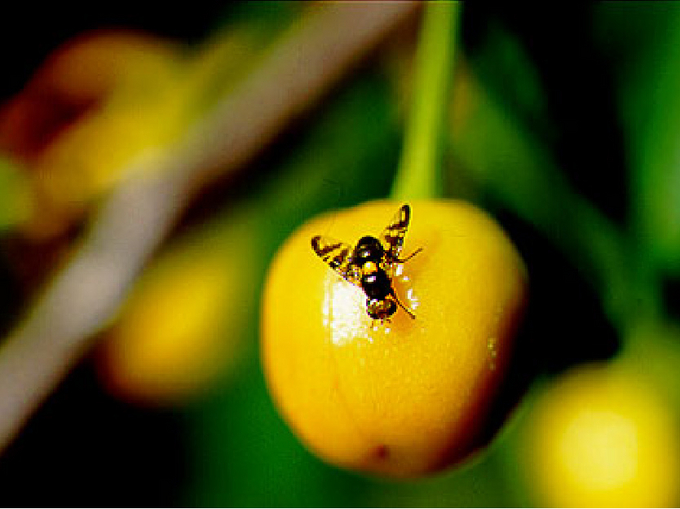European cherry fruit fly
Rhagoletis cerasi
Profile
The European cherry fruit fly(Rhagoletis cerasi) is an important native pest of the true fruit fly family (Tephritidae). As one of the most common pests of cultivated cherries, it usually attacks mid-late and late cherry cultivars starting in June. The larvae (maggots) feeding in the fruit destroy the pulp and make the fruit inedible.
Appearance
The adults of the European cherry fruit fly are 4 to 5 mm long, with glassy bright wings interspersed with dark bands. The shiny pale yellow dorsal shield is conspicuous on an otherwise shiny black body.
The headless and legless larvae (maggots) are white to cream and up to 6 mm long.


Biology
From around mid-May (depending on the weather), the cherry fruit flies hatch from pupae in which they have overwintered in the soil. Before they lay their eggs, the freshly hatched animals need a maturing period during which they feed on the sugary juices of the cherry trees, among other things.
Eight to ten days after hatching from the pupa, egg laying begins in sunny, warm weather. The eggs are laid one by one under the skin of cherries that are just turning color, and the fruit is then marked with a scent to signal to females arriving later that the fruit is already occupied. Each female can lay several hundred eggs in the course of her flight, which can last up to two months. About eight to twelve days later, the larvae (maggots) hatch and bore deeper into the flesh of the fruit. They now feed near the pit, often in the stem area of the fruit, for about three to four weeks.
The feeding activity of the fly maggots inside the cherries turns the pulp into a soft, rotten mass. When the ripening process of the cherries is complete, the development of the larvae is also complete and the adult larvae drop to the ground and pupate about 3 cm deep in the soil. The pupae overwinter in the soil, and mortality during it can be very high (> 80%) due to weather conditions. The majority of surviving pupae hatch the next year as a new generation, while up to 3% of pupae remain in the soil for more than one year.
Damage symptoms
Often infested fruits show externally around the stem area a brownish discolored area. Inside the fruit, the infestation can be detected by the soft and rotten flesh around the core, as well as by the presence of a maggot near the core. In infested areas, up to 80% affected fruit is not uncommon.
Since fruit flies only infest fruit, there is no damage to other parts of the plant such as leaves, trunk, branches or roots.
Host plants
As the most important domestic animal pest of cultivated cherries(Prunus avium), the European cherry fruit fly attacks medium-late and late cherry varieties from June onward. However, sour cherry(Prunus cerasus) and other Prunus species(e.g. bird and honeysuckle) are also considered host plants.
Prevention and control

- Variety selection: early-maturing cherry varieties are usually less affected
- Keep secondary hosts away: Remove or replant wild cherries; do not plant hedge cherries in infested areas.
- Hatching delay - relevant for orchards with mid-maturity varieties: late mowing of understory keeps soil cooler longer, this may delay adult hatch somewhat
- Hygiene in the orchard: early and, above all, complete harvesting also removes a large proportion of the larvae from the orchard; unusable (infested) fruit should also be removed from the orchard and destroyed without causing damage to prevent them from migrating into the soil
- Keeping poultry (hens) in the plant - they pick maggots and pupae from the ground, which can reduce infestation pressure
- Netting (physical barrier)
- nets should be installed from the beginning of flight until harvest (necessary mesh size: 1.3 mm)
- Plants with low tree heights - nets can be used to prevent fly influx into newly planted plants.
- Home gardens - it may be sufficient to install nets on individual branches in order to be able to harvest uninfested fruit from them.
- Ground covers of the tree disc (physical barrier)
- For high trunk plants - nets can be used to suppress hatching of adult cherry fruit flies from the ground
- Installation at the beginning of the flight (net edges are buried, necessary mesh size 0.8 mm), the flies must remain trapped under the net until harvesting
- A minimum distance of 200 m to other infested cherry trees is necessary!
- Yellow sticky traps (e.g. glue boards or comparable traps) to trap the adults
- To determine the beginning of the flight (by means of individual traps)
- To control or reduce infestation: depending on tree size, installation of two to ten traps at the beginning of flight, on the sunny side outside of the crown is recommended (to protect beneficial insects, however, use is only recommended from the beginning of flight until harvest).
- Pay attention to warning messages - we detect the beginning of the flight of adult cherry fruit flies by means of traps and announce them with warning messages.
- Optimal period for control is the maturation period of the flies (from hatching to egg laying).
- Plant protection products for the control of the cherry fruit fly are listed in the register of plant protection products approved in Austria.
Last updated: 28.10.2024
automatically translated